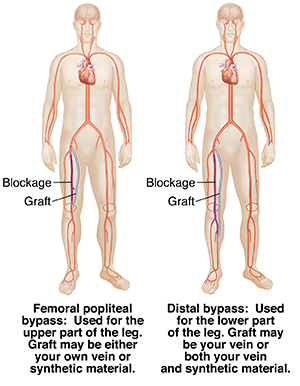Peripheral Artery Bypass Surgery
Peripheral Artery Bypass Surgery
Surgery to bypass a blocked leg artery can ease your symptoms. The bypass is done with a special tube (graft) that directs blood around the blockage.
Attaching the graft
Peripheral bypass grafts carry blood from the femoral artery in your thigh to an artery further down your leg. During the surgery, a graft is stitched into the artery above and below your blockage. This creates a new passage for blood flow. The blocked section of your artery is not removed. After the graft is in place, your doctor closes the cuts (incisions) in your skin with stitches or staples.
Types of grafts
A vein from your own legs or arms can be used as a blood vessel graft. Blood vessel grafts often come from your own leg. Vein grafts work better in long leg blockages that start from your groin and extend below your knee.
Manmade (synthetic) grafts are materials that your body easily accepts. These grafts work best on arteries at or above the knee.
Types of peripheral bypasses
The type of bypass depends on where your artery is blocked.
Risks and complications
Bleeding or blood clots
Urgent need for surgery again if graft is blocked by clot or debris
Graft blockage
Heart attack or stroke
Breathing problems
Infection
Need for second bypass or surgery to remove dead tissue (amputation)
Nerve damage and numbness
Complications from anesthesia
Updated:
March 21, 2017
Reviewed By:
Mancini, Mary, MD,Sather, Rita, RN
